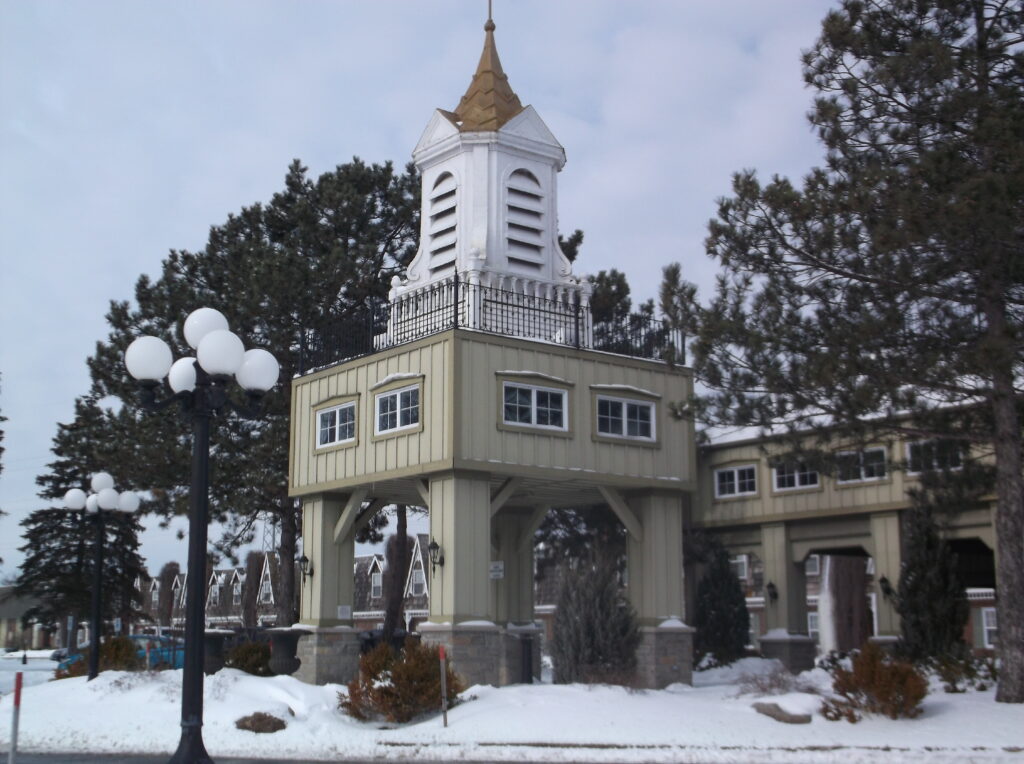REMARKABLE CORNWALL & SDG – RELIGIOUS MILESTONES
Given the emphasis on Scottish traditions in SD & G, it is easy to forget that the United Empire Loyalists, consisted of a number of ethnic and religious groups.
At their request, the Loyalists were broadly settled east to west according to nationality, language and religion. This resulted in Catholic Scottish Highlanders settling adjacent to the present day Quebec border, followed by Scottish Presbyterians, German Calvinists, German Lutherans and finally Anglicans. As Eastern Ontario can justifiably claim to be where “modern” Ontario was settled, these pioneers also founded many of Ontario’s historically dominant religions.
St. Andrews West is home to Upper Canada’s first English (and likely Gaelic) speaking Catholic Church when the parish was formed in the mid 1780s by United Empire Loyalists. The first log structure was replaced by the stone parish hall built between 1797 – 1801. Serving as a hospital during the War of 1812, The steeple was removed after the congregation moved into the present church in 1860.
The Reverend Alexander Macdonell arrived in Glengarry from Scotland as chaplain of the disbanded Glengarry Fencibles in 1804. Posted to serve the Raisin River Highlanders at St. Raphael’s Parish founded in 1786, he oversaw the construction of the present ruined stone church, which when completed, served as his administrative headquarters after he was made Bishop of Rhesina (Rosena) in 1820. He became the first Roman Catholic Bishop of Kingston (i.e. Upper Canada in 1826.)
To meet the spiritual needs of Cornwall’s burgeoning East End population bilingual Nativity Parish, Cornwall’s second Catholic community, was organized by Father J.J. Kelly in 1884. The church’s cornerstone was laid in 1887, and a year later, the Parish became French speaking under the direction of Father P.A. de Saunhac.
Nativity was consecrated the French language co-cathedral of the new diocese of Alexandria-Cornwall in 1976. When the diocese was amalgamated to become the Arch-diocese of Ottawa-Cornwall , Nativity became a Parish church.
Ontario’s first Lutheran congregation was formed in German speaking Williamsburg Township in 1784. Within six years the Lutherans built their first church, originally known as Zion Evangelical. The name was soon in changed to St. George’s Church. Bavarian born Johann S. Schwerdtfeger was the church’s first pastor when her arrived in Upper Canadian 1791, after being persecuted in the newly formed United States. for supporting the King.
Undergoing several drastic changes, the congregation settled into St. John’s Church, until they had to move to a new church in Riverside Heights due to Seaway flooding. Here the Reverend Pamela McGee became the first female minister in the United Counties and the first women to be ordained in Canada’s Lutheran Church.
This church closed in 2016.
Loyalist Reverend John Bethune established Presbyterianism in Upper Canada with the first log Kirk (church) of Scotland (Presbyterian) in Williamstown in 1787. The present church, St. Andrew’s United, completed in 1818, is the third church on this site. Recognizing the spiritual needs of Scottish Presbyterians throughout the area he founded Cornwall’s St. John’s congregation the same year. He also established parishes in Lancaster and Summerstown. Before he died in 1815 he baptised 2,576 people.
Cornwall’s French speaking Presbyterians formed a congregation in Cornwall in 1893 and worshiped in the “L’Eglise du Redempteur. The Reverend I. Bruneau led the faithful from 1910 to 1917 when the church closed and its members joined Knox.
Alexandria may not be the only place to be named after a pioneering Catholic Priest, but it surely ranks as one of the earliest and is certainly the only one to honour its founder twice. The site was originally named Priest’s Mill after Bishop Alexander Macdonell had a stone mill built here in 1819.
While Glengarry does not have the only Round Church I could locate in Canada, St. Andrew’s United in Dalhousie Mills, built in 1841 is still unique. Tradition holds that the church is round (octagonal) so that the devil could not hide in a corner.)
Warrior Clergymen.
Chaplains are integral members of the military. Even though they are prohibited from taking part in combat, chaplains might accompany fighting men into action to offer spiritual protection and fighting spirit. During the 1813 Battle of Ogdensburg, legend maintains that Catholic Father Alexander Macdonell , holding a towering Cross, took up position on one flank of the attacking Glengarry Light Infantry while a Presbyterian Minister (this could have been the Rev. John Bethune) with Bible in hand, advanced on the other flank. Giving the troops the choice between being killed by American fire or losing their mortal soul if they did not advance, W.J. Patterson in wrote:
“One of the men showed a disposition to fall to the rear; he was observed by (Macdonell), who sternly ordered him to resume his place. After a second warning…the man still held back, the Chaplain…halted and excommunicated him on the spot.“





